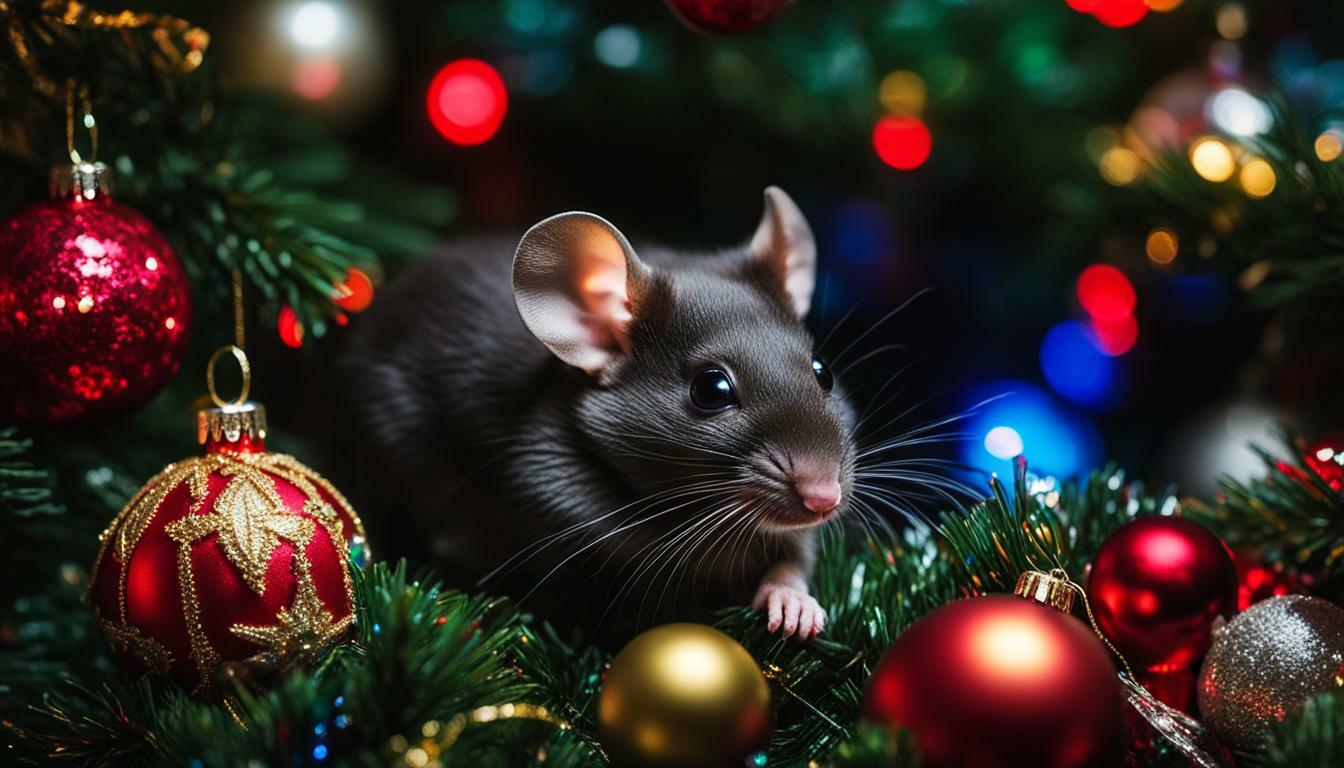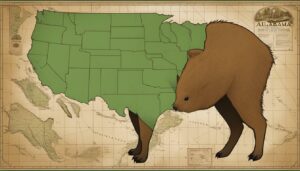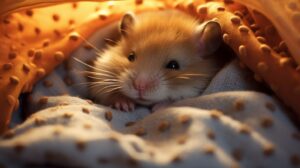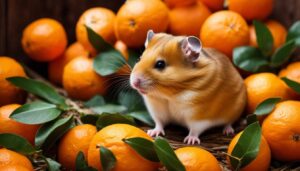Have you ever wondered if mice are drawn to Christmas trees during the holiday season? It turns out that these elusive creatures have a certain fondness for the festive decor. From climbing the tree and leaving droppings on decorations to gnawing on branches and ornaments, mice can certainly make their presence known. But why are they attracted to Christmas trees in the first place? Let’s explore the reasons and learn how you can keep your tree safe from these curious critters.
Key Takeaways:
- Mice are attracted to Christmas trees due to their climbing and jumping nature.
- Mice can cause damage by gnawing on branches and ornaments.
- Edible decorations like candy canes and popcorn can be a source of food for mice.
- Mice may chew on Christmas lights, posing a fire hazard.
- To prevent mice from affecting your tree, place it away from windows and doors, clean up pine needles regularly, and eliminate food sources nearby.
Why Are Mice Attracted to Christmas Trees?
Mice are irresistibly drawn to Christmas trees for a multitude of reasons. These curious creatures can’t resist the allure of a beautifully decorated tree, and they often find their way to the branches and ornaments. One of the main reasons is their ability to climb. Mice are skilled climbers, and the Christmas tree provides them with an exciting new playground. They can scurry up the branches, jump from branch to branch, and explore the entire tree, leaving behind droppings that may fall onto your precious decorations.
In addition to their climbing antics, mice have a natural instinct to gnaw on objects. This includes tree branches and ornaments. Their sharp teeth allow them to gnaw through the branches, causing damage to the tree itself. It’s not uncommon to find chewed-up ornaments or even missing branches thanks to these tiny intruders. This gnawing behavior can also extend to the electrical wires of Christmas lights, posing a potential fire hazard.
Food and water sources play a significant role in attracting mice to Christmas trees. The tree can provide them with both. Edible decorations like candy canes and popcorn can be irresistible to mice, who view them as a tasty snack. Additionally, pine needles can serve as a source of food and hydration for these small rodents. To make matters worse, the presence of food and water can encourage mice to linger around your tree, increasing the chances of further damage.
To prevent mice from wreaking havoc on your Christmas tree, there are several precautions you can take. Firstly, consider placing your tree away from windows and doors, as this can deter mice from entering your home in the first place. Regularly clean up fallen pine needles, as they can attract mice. Also, ensure that there is no food on or near the tree to discourage their presence. It’s important to check for signs of rodents, such as droppings, before setting up an artificial tree. And if you suspect mice in your home, using repellents can help keep them away from your festive decorations.
| Reasons Mice Are Attracted to Christmas Trees |
|---|
| 1. Climbing opportunities |
| 2. Gnawing behavior |
| 3. Edible decorations |
| 4. Pine needles as a food source |
| 5. Potential fire hazards with Christmas lights |
Mice and Decorations: What You Need to Know
When it comes to Christmas decorations, mice can be quite mischievous, especially when it comes to ornaments. These furry creatures are known to chew on delicate decorations, causing damage and potential hazards. To ensure your festive decor remains intact, it’s important to understand how mice interact with decorations and take necessary precautions.
Chewing on Ornaments
Mice have a natural instinct to chew, and ornaments can become the perfect target for satisfying this behavior. Delicate materials like glass, plastic, or even fabric are not safe from their gnawing teeth. Not only can this ruin the appearance of your ornaments, but it can also pose a risk if they break into small, sharp pieces. To protect your precious decorations, consider using shatterproof ornaments or placing fragile ones higher up on the tree, out of the reach of curious mice.
Potential Hazards
In addition to the damage caused by chewing, mice can also create potential hazards with their presence around decorations. If mice are attracted to your Christmas tree, they may leave droppings that can contaminate nearby surfaces and pose health risks. These droppings can fall onto decorations, making them unsanitary and requiring thorough cleaning. Keep an eye out for signs of mice, such as droppings or chew marks on ornaments, and take swift action to address the issue.
Preventing Mice Infestation
To keep mice away from your Christmas tree and decorations, there are several preventive measures you can take. Firstly, ensure your tree is placed away from windows and doors, as these are common entry points for mice. Additionally, regularly clean up any pine needles that fall from the tree, as they can provide nesting material and attract mice. Avoid placing food on or near the tree, as this can be a strong attractant. Using repellents specifically designed to deter rodents can also be effective in keeping mice away from your holiday decor.
| Preventive Measures | Benefits |
|---|---|
| Placing the tree away from windows and doors | Reduces the chances of mice finding their way to your tree |
| Cleaning up pine needles regularly | Removes potential nesting material and reduces mouse attraction |
| Avoiding placing food on or near the tree | Eliminates a strong attractant for mice |
| Using repellents | Deters mice from approaching your Christmas decorations |
By being proactive in preventing mice infestation, you can ensure that your Christmas tree and ornaments remain beautiful and intact throughout the holiday season. With a little care and attention, you can enjoy your festive decor without the worry of mice causing damage or creating potential hazards.
Food and Water Sources for Mice in Christmas Trees
Believe it or not, your lovely Christmas tree can serve as a tempting buffet for curious mice. These tiny creatures are not only attracted to the festive decorations but also find the tree itself to be a source of food and water. To protect your tree and ensure a rodent-free holiday season, it’s crucial to understand the potential food and water sources that can attract mice.
One of the main culprits for inviting mice into your Christmas tree is the edible decorations. Yes, those delightful candy canes and popcorn strings can be irresistible to these little foragers. Mice may find their way to your tree, lured by the scent and taste of these treats. Remember to keep an eye on your edible decorations and consider using non-edible alternatives to avoid feeding the mice.
Another unexpected food source for mice in Christmas trees is the pine needles. As the tree sheds its needles, they can accumulate on the floor or under the tree, creating a cozy hiding spot and a potential feast for mice. Regularly clean up the fallen needles to minimize the chances of attracting these unwanted guests.
| Potential Food and Water Sources for Mice | Preventive Measures |
|---|---|
| Edible decorations like candy canes and popcorn strings | Consider using non-edible alternatives |
| Pine needles from the tree | Clean up fallen needles regularly |
Lastly, mice may see your Christmas lights as a tasty treat. They can chew on the electrical wires, creating a potential fire hazard. To prevent accidents, ensure that the lights are securely fastened and out of reach from curious mice. Additionally, consider using rodent-repellent sprays or devices near your tree to discourage mice from getting too close.
In summary, it’s essential to be aware of the food and water sources that can attract mice to your Christmas tree. By using non-edible decorations, cleaning up fallen pine needles, and securing your lights, you can enjoy a rodent-free holiday season and preserve the festive spirit in your home.
Fire Hazards: Mice and Christmas Lights
While mice may seem harmless, their tendency to gnaw on Christmas lights can lead to dangerous fire hazards. These tiny creatures are attracted to the wires of Christmas lights, mistaking them for potential food sources or simply seeking something to chew on. Unfortunately, their chewing can expose the electrical wires within the lights, increasing the risk of electrical shorts and sparks that can ignite a fire.
To minimize the fire risk associated with mice and Christmas lights, it’s essential to take safety precautions. Here are some steps you can follow:
- Inspect your lights: Before decorating your tree, carefully examine all the strings of lights for signs of mouse damage. Look for frayed wires, exposed metal, or any other indications that mice may have been chewing on them. Discard any damaged lights and replace them with new ones.
- Secure your lights: Once your lights are in place, ensure they are securely attached to the tree and cannot be easily accessed by mice. Use twist ties or clips to secure the wires, making it harder for mice to get to them.
- Consider alternative lighting: If you’re concerned about the fire hazard posed by traditional Christmas lights, consider using LED lights instead. LED lights produce less heat and are less likely to cause a fire if chewed on by mice.
- Keep an eye on your tree: Regularly check your Christmas tree for any signs of mice, such as droppings or gnaw marks. If you suspect mice infestation, take immediate steps to remove them from your home and ensure they cannot access the tree.
By being proactive and taking these safety precautions, you can enjoy the festive glow of Christmas lights without worrying about the potential fire hazards associated with mice. Remember, prevention is key when it comes to keeping your home safe during the holiday season.
| Step | Action |
|---|---|
| 1 | Inspect your lights for damage |
| 2 | Secure lights to the tree |
| 3 | Consider using LED lights |
| 4 | Regularly check your tree for signs of mice |
Preventing Mice Infestation Around Your Christmas Tree
Don’t let mice ruin your holiday cheer – follow these simple steps to keep them away from your Christmas tree. Placement is key when it comes to preventing mice infestation. Make sure to position your tree away from windows and doors, as these are common entry points for rodents. Additionally, avoid placing the tree near any potential food sources that may attract mice, such as pet food or kitchen counters.
Maintaining cleanliness around your Christmas tree is crucial. Regularly clean up pine needles that fall from the tree, as these can be enticing to mice seeking nesting material. Vacuuming or sweeping the area around the tree will help eliminate any crumbs or food particles that may have dropped. Keeping the tree skirt clean and free of food debris will also discourage mice from approaching.
Be mindful of food proximity to your tree. Mice are attracted to edible decorations like candy canes and popcorn. To minimize the risk of attracting them, avoid hanging these types of ornaments on the lower branches. Instead, opt for non-edible decorations made from materials that mice are less likely to chew on. This will help protect both your ornaments and the safety of your Christmas tree.
Checking for rodent signs
Before setting up an artificial tree, it’s essential to inspect it for any signs of rodents. Look for chew marks, droppings, or nesting materials in and around the storage area. If you spot any signs of mice, take appropriate measures to address the issue before bringing the tree into your home. Using repellents in and around the storage area can also help deter mice from infesting your artificial tree.
| Steps to Prevent Mice Infestation Around Your Christmas Tree: |
|---|
| 1. Place the tree away from windows and doors |
| 2. Clean up pine needles frequently |
| 3. Avoid placing the tree near food sources |
| 4. Use non-edible decorations |
| 5. Check for signs of rodents before setting up an artificial tree |
| 6. Use repellents to deter mice |
Artificial Trees: Checking for Rodent Signs
Even if you choose an artificial tree, it’s essential to ensure it’s free from any unwanted furry visitors. Before setting up your artificial Christmas tree, take a few minutes to inspect it for signs of rodents. This simple step can help prevent any potential infestations and ensure a pest-free holiday season.
Start by carefully examining the branches and the base of the tree for any visible signs of rodent activity. Look for chew marks, gnawed areas, or droppings. Mice and other rodents are known to leave behind these telltale signs. If you notice any of these signs, it’s important to take action before bringing the tree into your home.
If you find evidence of rodent presence, thoroughly clean and sanitize your artificial tree. Use a mild detergent or a mixture of water and vinegar to wipe down all the branches and surfaces. Pay extra attention to the areas where you found signs of infestation. This cleaning process will help remove any lingering odors that may attract rodents.
Table: Steps to Check for Rodent Signs
| Step | Action |
|---|---|
| 1 | Inspect branches and base |
| 2 | Look for chew marks, gnawed areas, or droppings |
| 3 | Clean and sanitize the tree if signs are found |
After performing the necessary cleaning, store your artificial tree in a secure location. Choose an area that is inaccessible to rodents, such as a sealed plastic container or a sturdy storage bag. Avoid storing the tree in a basement or garage where rodents may have easier access.
By following these simple steps, you can ensure that your artificial Christmas tree remains free from any unwanted furry visitors. Keep your home pest-free and enjoy a festive holiday season without any worries.
Conclusion
By taking proactive measures to prevent mice from being attracted to your Christmas tree, you can maintain a festive and rodent-free holiday season.
Mice are naturally drawn to Christmas trees for various reasons. They are agile climbers and may use the branches as a playground, causing droppings to fall on precious decorations. Their chewing habits can also pose a threat to the tree, with branches and ornaments becoming targets.
Additionally, Christmas trees provide mice with a source of food and water. Edible decorations like candy canes and popcorn can be irresistible to these critters. Furthermore, mice may even chew on Christmas lights, which can lead to dangerous fire hazards.
To prevent mice from disrupting your tree and potentially infesting your home, it is essential to take certain precautions. Firstly, place your tree away from windows and doors, as these are common entry points for mice. Regularly clean up fallen pine needles, as they can attract rodents. Avoid leaving any food or crumbs on or near the tree, as this can entice mice to explore further. Additionally, consider using repellents to deter mice from approaching your tree.
For those opting for an artificial Christmas tree, it is essential to check for signs of rodents before setting it up. Inspect the storage area for any droppings or chew marks that may indicate rodent activity. Taking these steps can help ensure a rodent-free holiday season and allow you to fully enjoy the festive atmosphere.
FAQ
Do mice like Christmas trees?
Yes, mice are attracted to Christmas trees for various reasons.
Why are mice attracted to Christmas trees?
Mice are attracted to Christmas trees because they can climb them, jump from branch to branch, and find food and water sources like edible decorations.
How can mice interact with Christmas decorations?
Mice may gnaw on branches and ornaments, causing damage to the tree and potentially posing hazards.
What are the food and water sources for mice in Christmas trees?
Mice are attracted to edible decorations like candy canes and popcorn, as well as pine needles. Cleaning up pine needles frequently can help prevent their presence.
Can mice pose a fire hazard when it comes to Christmas lights?
Yes, mice may chew on Christmas lights, which can create a fire hazard due to damaged electrical wires. Taking safety precautions is important to prevent accidents.
How can I prevent mice infestation around my Christmas tree?
It is recommended to place your tree away from windows and doors, clean up pine needles frequently, and ensure there is no food on or near the tree. Using repellents and checking for signs of rodents can also help.
How can I check for rodent signs when setting up an artificial tree?
Before setting up an artificial Christmas tree, inspect it for signs of rodents. Also, ensure proper storage to avoid future infestations.
What are the key points regarding mice and Christmas trees?
Mice are attracted to Christmas trees for various reasons and can cause damage and potentially pose hazards. Prevention measures, such as proper placement, cleanliness, and regular inspections, are important to avoid infestations.




